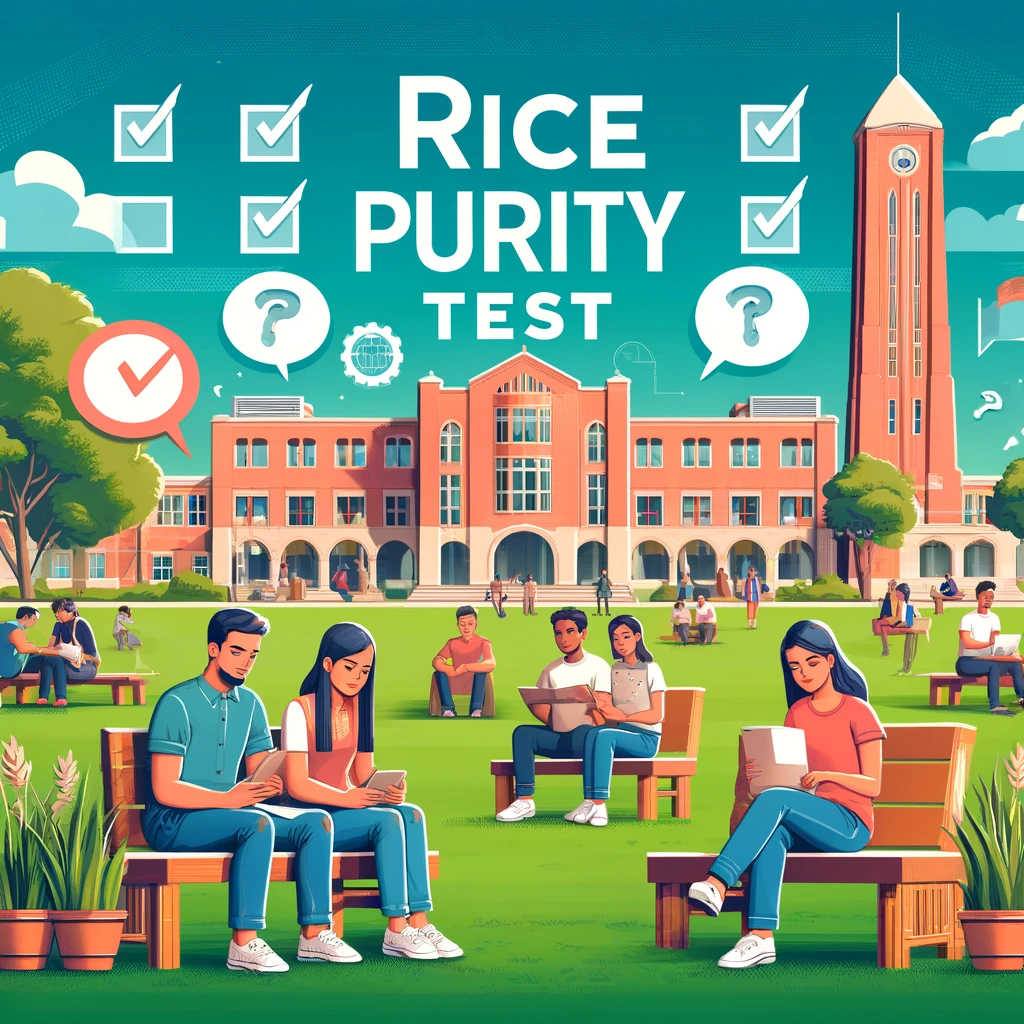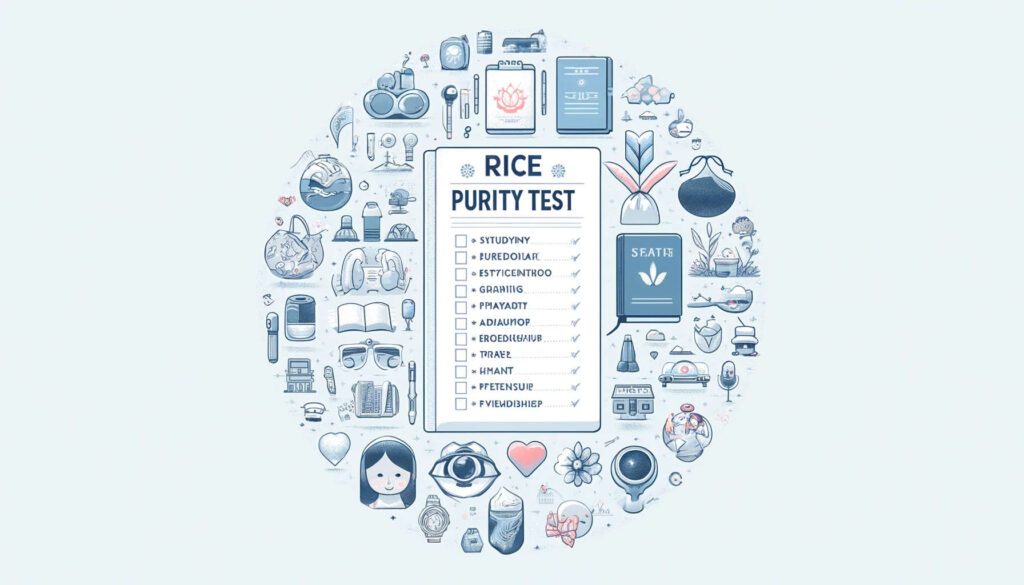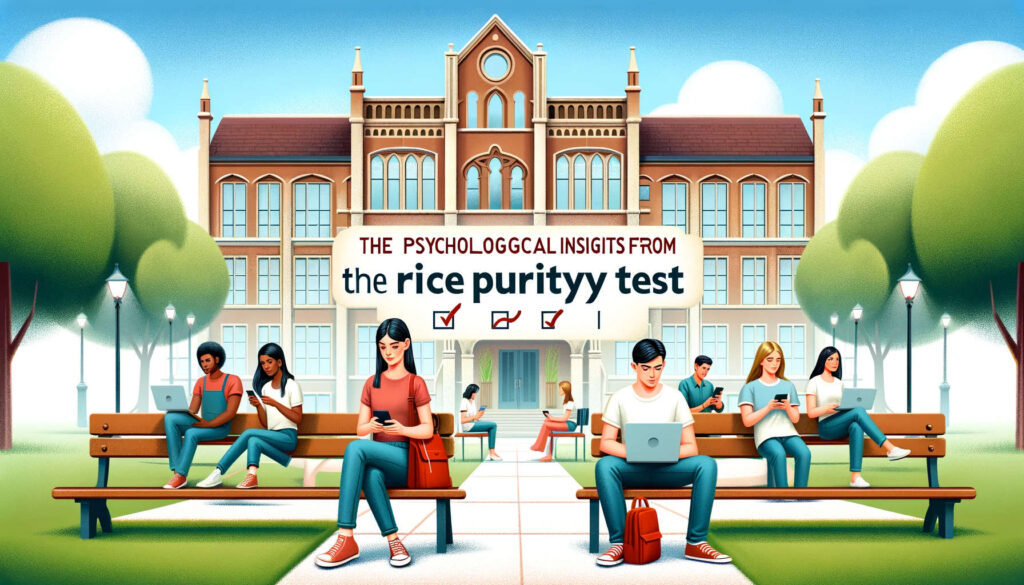In the realm of online quizzes and personality tests, the Rice Purity Test stands out as a peculiar yet fascinating tool. Originally designed as a self-administered survey for college students, the test consists of 100 questions that probe various life experiences, ranging from the innocent to the risqué.
The primary purpose of the test is to gauge an individual’s level of “purity” based on their answers, with a higher score indicating fewer life experiences deemed impure or rebellious.
About the Rice Purity Test
The Rice Purity Test originated at Rice University in Houston, Texas, during the 1920s. It was initially created as a fun way for students to bond and share their experiences in a non-judgmental environment.
Over the decades, the test has evolved, gaining popularity far beyond its initial confines. Today, it is widely circulated among college students across the United States and beyond, often serving as an icebreaker or a means of self-reflection.
The popularity of the Rice Purity Test among college students can be attributed to several factors:
- Curiosity and Self-Discovery: Students are often curious about how their experiences compare to those of their peers.
- Peer Bonding: Sharing test results can strengthen friendships and create a sense of camaraderie.
- Entertainment: The test is often taken for fun, providing a humorous and lighthearted activity.
By exploring the psychological insights gleaned from the Rice Purity Test, we can gain a deeper understanding of individual behaviors and societal norms. This blog post delves into the history and background of the test, its structure and content, and the psychological revelations it offers.
Understanding the Rice Purity Test
History and Background
Origin at Rice University
The Rice Purity Test was conceived at Rice University as a way to promote student interaction and camaraderie.
Initially circulated among freshmen, the test aimed to break the ice and encourage students to share their life experiences in a safe and supportive environment.
The test quickly became a tradition at the university, marking a rite of passage for new students.

Evolution and Current Form
Over the years, the Rice Purity Test has evolved from a local university tradition to a widely recognized online phenomenon.
The test’s questions have been updated to reflect changing societal norms and experiences, but the core concept has remained the same. Today, the test is easily accessible online and is taken by people from diverse backgrounds and age groups, though it remains particularly popular among college students.
Structure and Content
Types of Questions Asked
The Rice Purity Test consists of 100 yes-or-no questions that cover a broad spectrum of life experiences. These questions are designed to assess various aspects of a person’s behavior and history, including:
- Innocent Activities: Holding hands, going on a date, or attending a sleepover.
- Romantic and Sexual Experiences: Kissing, sexual intercourse, and other intimate activities.
- Substance Use: Drinking alcohol, smoking, and using recreational drugs.
- Law and Order: Encounters with law enforcement, such as being arrested or detained.
Scoring System
The scoring system of the Rice Purity Test is straightforward. Each “yes” answer corresponds to a specific experience, and the total number of “yes” answers is subtracted from 100 to determine the final score.
A higher score indicates a higher level of “purity,” suggesting that the individual has had fewer of the listed experiences. Conversely, a lower score indicates more experiences and a perceived lower level of purity.

The Appeal of the Rice Purity Test
Social and Cultural Context
Role in College Culture
The Rice Purity Test has become a staple in college culture, often serving as a rite of passage for incoming freshmen. It acts as an icebreaker, facilitating conversations about personal experiences in a light-hearted and non-threatening manner.
This shared activity helps new students bond quickly and establish a sense of community.
Group Dynamics and Peer Influence
In group settings, taking the Rice Purity Test can reveal similarities and differences among peers, fostering a deeper understanding and acceptance of diverse backgrounds.
The influence of peers can significantly impact how individuals perceive and engage with the test:
- Normalization of Experiences: Sharing test results can normalize various experiences, reducing feelings of isolation or abnormality.
- Encouragement of Openness: Group participation can encourage individuals to be more open about their experiences, promoting honesty and transparency.
Psychological Attraction
Curiosity and Self-Discovery
The test’s allure lies in its ability to satiate curiosity. Individuals are often eager to see how their life experiences compare to those of others. This process of self-discovery can be both enlightening and validating.
Social Comparison and Belonging
Humans have an inherent desire to belong and fit in. The Rice Purity Test provides a framework for social comparison, allowing individuals to gauge where they stand relative to their peers.
This can lead to a sense of belonging or highlight areas where they differ, both of which are valuable for personal and social development.

Psychological Insights from the Test
Personality Traits and Behaviors
Correlation with Risk-Taking Behavior
The Rice Purity Test can offer insights into an individual’s propensity for risk-taking. Lower scores, indicating more life experiences, often correlate with higher levels of risk-taking behavior.
This can be linked to personality traits such as sensation-seeking and impulsivity.
Reflection of Personality Traits
The test can reflect various personality traits:
- Openness: Individuals with lower scores may exhibit higher levels of openness to experience, indicating a willingness to engage in diverse activities.
- Conscientiousness: Higher scores might suggest greater conscientiousness, reflecting cautiousness and a preference for rule-following behaviors.
Developmental Psychology
Age and Life Stage Considerations
The stage of life at which individuals take the Rice Purity Test can significantly influence their scores.
Younger individuals, particularly those in late adolescence and early adulthood, are in a developmental phase characterized by exploration and identity formation. This is often reflected in their test responses.
Impact of Environment and Upbringing
Environmental factors and upbringing play crucial roles in shaping behaviors and experiences. For instance, individuals from more conservative backgrounds might have higher scores, while those from more liberal environments might have lower scores.
These differences can highlight the impact of cultural and familial influences on personal development.
Social Psychology
Influence of Peer Pressure
Peer pressure can greatly affect how individuals respond to the Rice Purity Test. The desire to fit in or to appear adventurous can lead to either exaggeration or downplaying of certain experiences.
Role in Social Identity and Group Cohesion
The test can also influence social identity and group cohesion. By sharing scores and discussing experiences, individuals can form stronger group bonds and a more cohesive group identity.
This shared activity helps to reinforce group norms and values, fostering a sense of unity and belonging.

The Impact of Scores and Interpretations
Personal Reflection and Growth
Use of Scores for Self-Assessment
The Rice Purity Test provides a numerical score that can serve as a tool for self-assessment. Individuals can use their scores to reflect on their life choices and experiences.
This reflection can lead to a better understanding of their personal values, boundaries, and the factors that have influenced their behavior.
Potential for Introspection and Behavior Change
For some, taking the test prompts introspection about past behaviors and future aspirations. This can lead to meaningful behavior change, such as adopting healthier habits or making more conscious decisions. The test can act as a catalyst for:
- Reevaluating Life Choices: Individuals might reconsider past actions and their impact on their lives.
- Setting Personal Goals: The test can inspire goal-setting for future personal growth and development.
Social Perception and Judgment
How Scores Influence Perceptions of Others
Scores on the Rice Purity Test can significantly influence how individuals are perceived by their peers. Higher scores might be associated with innocence or naivety, while lower scores could be linked to adventurousness or risk-taking.
These perceptions can affect social interactions and relationships.
Stigmatization and Acceptance within Social Groups
Within social groups, scores can lead to both stigmatization and acceptance. Individuals with scores that deviate significantly from the group norm might experience judgment or exclusion.
Conversely, scores that align with group norms can enhance social acceptance and cohesion. The impact of scores includes:
- Positive Reinforcement: Encouraging behavior that aligns with group values.
- Negative Judgment: Potential for judgment or stigmatization based on perceived “purity” or lack thereof.
Criticisms and Limitation
Validity and Reliability
Questionable Accuracy in Measuring “Purity”
The concept of “purity” as measured by the Rice Purity Test is inherently subjective and culturally relative. The test’s accuracy in truly reflecting an individual’s purity is debatable, as it relies on a narrow set of experiences that may not encompass all dimensions of personal and moral development.
Variability in Individual Interpretations
Individuals interpret and respond to the test’s questions differently, leading to variability in scores. Factors such as personal definitions of certain terms and cultural differences can affect how questions are understood and answered.
Ethical and Privacy Concerns
Potential for Misuse of Personal Information
The sensitive nature of the questions poses significant privacy concerns. If not taken anonymously, the results can be misused or disclosed without consent, leading to potential harm or embarrassment.
Psychological Impact of Taking the Test
Taking the Rice Purity Test can have psychological impacts, especially for those who might feel pressured to conform to certain norms or who experience anxiety over their scores. The test can evoke feelings of inadequacy or shame in some individuals, particularly if their scores are judged harshly by peers.
Conclusion
Summary of Key Points
The Rice Purity Test, while initially a simple college activity, offers a complex interplay of social and psychological insights. It reflects personal experiences, influences social dynamics, and provides a platform for self-assessment.
Recap of Psychological Insights from the Rice Purity Test
- Personality Traits and Behaviors: Reveals tendencies towards risk-taking and openness.
- Developmental Psychology: Highlights the influence of age, life stage, and upbringing.
- Social Psychology: Emphasizes the role of peer pressure and social identity.
Final Thoughts on the Test’s Role in Modern Culture
The test’s enduring popularity underscores its role in facilitating conversations about personal experiences and societal norms. It serves as a mirror reflecting both individual behaviors and collective cultural values.


